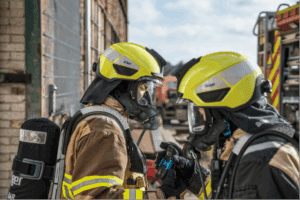In the face of overwhelming pressure put on Ukrainian fire and rescue teams during a national conflict, the rest of the world steps in to offer their support
It is now approaching half a year where the headlines have been filled with news about the ongoing conflict in Ukraine. It’s not an understatement to say the lives of its denizens have been turned upside down by the constant threat of destruction to their homes and municipal facilities. The toll the war has exacted is heavy, with entire neighbourhoods levelled by bombs and artillery, Ukrainian soldiers deployed across the country to aid in defence of the invasion, as well as countless lives needlessly lost.
But it is not only military forces that are spread thin in their efforts to protect the population: fire and rescue services are struggling to keep up with a level of responses on a nationwide scale, as every corner of country comes under threat of bombs and fire. Ukraine were already ill-equipped before the war even started, which has them scrambling to use what they can to save the populace. Outdated, archaic and rudimentary equipment are all these firefighters have to deal with the largest catastrophe in their nation’s recent history. Every citizen they save is a Pyrrhic victory, as many others lose their lives due to lack of staff, training or advanced equipment. As the war rages on, so do these resources diminish.
But Ukraine’s cries for help haven’t been lost in the howling winds. Nations across the world have been united in showing solidarity for them and offering aid in whatever way they can. Huge convoys of donated PPE, fire engines, thermal imaging equipment, generators, hoses, lighting and rescue equipment have already made their way across Ukrainian borders to assist firefighters in their efforts to save the population. Brave organisations have made the journey into the country to offer invaluable training and volunteering for those on the front line, as well as developing online training courses that can be readily accessed by Ukrainian firefighters across the country. We’ll take a closer look at just how dire the situation in the country is, as well as the methods employed by outside benefactors to aid fire and rescue efforts.
Even before Russia invaded Ukraine, the fire departments there were ill-equipped to deal with such a widespread scale of reports. How well a country is able to deal with a sudden and unexpected threat such as this hinges entirely on the surplus of equipment, facilities and staff available prior to the attack: for every one of this criterium, Ukraine was found overwhelmingly lacking. And with the conflict, these numbers have only diminished further – as of April this year, 26 Ukrainian rescue workers have been killed, six captured and 50 have been injured as a direct result of the war, with over 400 life support equipment, 1000 educational institutions, 285 healthcare facilities and 71000 homes destroyed.
Money cannot be injected into fire and rescue services, either – Ukraine is already a poor country, this issue exacerbated by the annexation of the country as well as funds already being allocated to military and evacuation efforts.
To read more exclusive features and latest news please see our June issue here.
Media contact
Rebecca Morpeth Spayne,
Editor, International Fire Buyer
Tel: +44 (0) 1622 823 922
Email: [email protected]




































